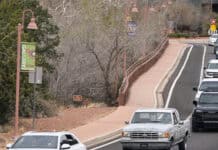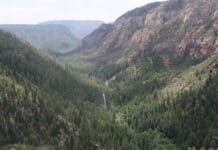A year following the collapse of a busy Minnesota freeway bridge, the Arizona Department of Transportation can affirm the safety of its bridge infrastructure.
With more than 4,000 bridges in the ADOT system, the safety of state bridges is among the best in the nation with 98.5 percent of structures receiving excellent or good inspection ratings.
Arizona benefits from a mild climate, relatively recent construction of most bridges and a solid commitment to bridge safety.
A year following the collapse of a busy Minnesota freeway bridge, the Arizona Department of Transportation can affirm the safety of its bridge infrastructure.
With more than 4,000 bridges in the ADOT system, the safety of state bridges is among the best in the nation with 98.5 percent of structures receiving excellent or good inspection ratings.
Arizona benefits from a mild climate, relatively recent construction of most bridges and a solid commitment to bridge safety.
These factors help ADOT and local transportation officials preserve and maintain this critical transportation infrastructure. Within ADOT’s network, there are about 4,700 total bridges with 1.5 percent classified as “structurally deficient,” meaning the bridge is safe but requires some repair, stated a press release.
Across Arizona, federal reports tally about 7,350 total bridges owned by the state and local governments; 180 bridges total are currently rated as safe but “structurally deficient.”
A USA Today analysis last week reported that Arizona was tied with Delaware and Florida for the smallest percentage of bridges that were deemed “structurally deficient.”
This affirms a 2007 report by Time magazine showing that Arizona had the safest network of bridges in the nation. In 2006, the American Society of Civil Engineers gave Arizona an overall grade of A- for highway bridge safety, stated the release.
Examining the 20 most traveled bridges in Arizona requiring repair, ADOT provided data to the Associated Press showing that over the past year:
* ADOT fully repaired or is currently improving five of the 20 busiest bridges.
* ADOT has scheduled eight of the 20 busiest structures for repair or replacement.
* ADOT completed partial fixes for identified deficiencies at two of the busiest bridges.
* Two bridges were determined to have limited capacity with no critical safety issues.
* ADOT determined one bridge to be a safe box-culvert structure.
* Local governments own four of the top 20 busiest bridges needing repair.
Across the state, ADOT continues to invest more than $20 million annually for bridge preservation efforts completing maintenance and repairs on a priority basis. On average, the agency repairs as many as two dozen bridges every year throughout the state.
While 98.5 percent of ADOT’s bridges are in good or excellent condition, challenges loom for Arizona and other states as aging infrastructure requires more maintenance.
ADOT is joining the American Association of State Highway and Transportation Officials in calling for greater national focus on highway infrastructure and bridge maintenance funding. AASHTO estimates $140 billion is needed to improve the nation’s bridges.
Bridging the Gap, an AASHTO report released July 28, identifies several challenges facing bridge improvements across the nation including soaring construction costs, congestion, age and deterioration and pressing maintenance needs.
Investment, research and innovation, systematic maintenance programs and diverse funding options to implement needed improvements are identified as opportunities to protect and expand the nation’s network of 590,000 bridges.
For more on the nation’s bridges and strategies to enhance these connections, visit www.transportation.org.
More information on ADOT’s bridges is available at www.azdot.gov.





















